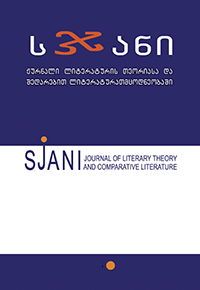ზმის განმარტებისათვის
On the Definition of the Term "Pun"
Author(s): Levan BregadzeSubject(s): Literary Texts
Published by: ლიტერატურის ინსტიტუტის გამომცემლობა
Keywords: Akaki Khintibidze; pun;
Summary/Abstract: Akaki Khintibidze, in his work “Rhyme and Pun”, has critically studied the existing definitions of the term “pun” and has formed his own explanation of this word (Khintibidze 2001: 97-102). He writes: “In accordance with the existing samples of Georgian pun and the literature about it, the term can be defined in the following way: it is a word interwoven implicitly into the text, which is obtained by means of merging two or three adjacent words or their parts (Khintibidze 2001: 102). In all the samples of pun, discussed by A. Khintibidze, implicated meaning is really expressed by a single word. However, there exist puns, where implied meaning is expressed by two or more words. From this viewpoint, it is worth mentioning Rostom Eristav’s epistle written to Solomon I, where we come across the triple pun expressed by two words. In addition, in Nino Darbaiseli’s verse, written about the death of Aleksandre Gvakharia, pun was expressed twice in five words (Darbaiseli 2004: 16). Moreover, Nino Darbaiseli was the first who used nine-syllable pun. Akaki Khintibidze considers that pun is formed as a result of merging of adjacent words or their parts. Sometimes it is really formed by joining words or some parts of adjacent words. (Akaki’s verses can serve as a proof). It is occasionally formed not by the merging of adjacent words and parts of words, but by the rearrangement of the syllables (sometimes of the sounds) between the words in a new way. Examples of such kind of pun we can see in Rostom Eristav’s and Nino Darbaiseli’s puns. Besides, there are puns formed by separating a part from the word. Examples of this kind of pun can be noticed in Davit Guramishvili’s works, Besik’s and Teimuraz II’s verses. We consider it crucial the definition of the term to reflect such cases. zmis ganmartebisaTvis 209 While assessing Niko Chubinashvili’s definition Akaki Khintibidze wrote: Niko Chubinashvili considers that “pun is formed as the result of merging of two or more words. It is not fair to point to several words as there does not exist a pun with more than three words” (Khintibidze 2001: 101). Leli Japaridze’s homonymic rhyme and Nino Darbaiseli’s puns point to the existence of a pun consisting of more than three words. Folk puns consisting of four words also serve as a proof. Therefore, Akaki Khintibidze’s definition “two or three adjacent words” should be changed into “two or more adjacent words”. After taking into consideration all the above mentioned facts, Akaki Khintibidze’s definition of the term should be as follows: Pun is a word (words) interwoven implicitly into a text, which is (are) obtained by means of (1) merging two or more adjacent words or their parts, (2) isolating some part of a word, or (3) rearrangement of the syllables (sometimes of the sounds) between the words in a new way.
Journal: სჯანი
- Issue Year: 2009
- Issue No: 10
- Page Range: 206-209
- Page Count: 3
- Language: Georgian

